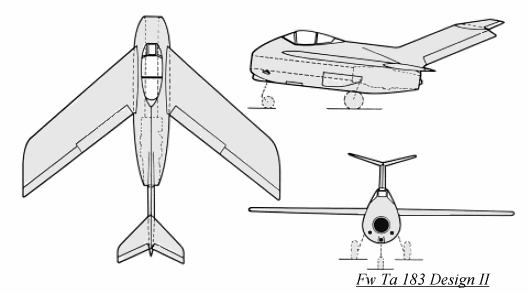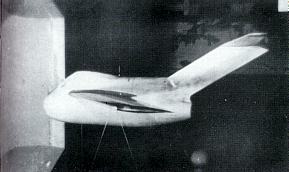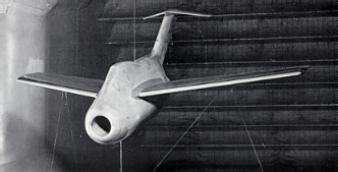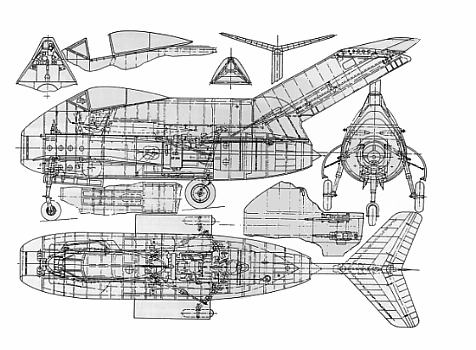 In late 1942, Focke-Wulf engineer Hans Multhopp
headed up a design team that started aerodynamic studies for a new turbojet
fighter. This culminated in 1945 as a fighter project known as "Huckebein"
(a cartoon raven that traditionally makes trouble for others), also
known as Project V (Project VI in some references) or Design II at Focke-Wulf
and later to be given the designation Ta 183. The Ta 183 had a short, squat
fuselage with the air intake passing under the cockpit and proceeding to
the rear where the single He S 011 turbojet was located, although the first
three prototypes were to be powered by Jumo 004B jet engines. A provision
was made in the early studies for the aircraft to be equipped with a 1000
kg (2205 lbs) thrust rocket engine to assist interception duties, with the
fuel for a 200 second rocket burn being located in underwing drop tanks.
The wings were very thin, swept back at 40 degrees and were mounted in the
mid-fuselage position. A tapered main wing spar constructed of two duraluminum
I-beams with steel flanges formed a torque box, with the attachment at the
fuselage consisting of a single bolt. The wing structure was completed by
adding bonded wooden ribs with a plywood covering. Each wing panel contained
six fuel cells totaling 1565 liters (345 gallons). The huge fin was swept
back at 60 degrees, with the tailplane mounted on the top of the fin. The
tailplane also exhibited considerable dihedral. Wing elevons and the rudder
provided control, the tailplane control surfaces only being used for trimming.
The flaps and landing gear were operated hydraulically. The pilot sat in
a pressurized cockpit with a bubble canopy which provided excellent all-around
vision. Four MK 108 30mm cannon was envisioned for the production Ta 183
armament, also a bomb load of 500 kg (1100 lbs) could be carried. This could
include one SD or SC 500 bomb, one BT 200 bomb, five SD or SC bombs and even
a Rb 20/30 camera. The weapons load would be carried in the equipment space
in the bottom of the fuselage and thus partially protrude about halfway from
the fuselage.
In late 1942, Focke-Wulf engineer Hans Multhopp
headed up a design team that started aerodynamic studies for a new turbojet
fighter. This culminated in 1945 as a fighter project known as "Huckebein"
(a cartoon raven that traditionally makes trouble for others), also
known as Project V (Project VI in some references) or Design II at Focke-Wulf
and later to be given the designation Ta 183. The Ta 183 had a short, squat
fuselage with the air intake passing under the cockpit and proceeding to
the rear where the single He S 011 turbojet was located, although the first
three prototypes were to be powered by Jumo 004B jet engines. A provision
was made in the early studies for the aircraft to be equipped with a 1000
kg (2205 lbs) thrust rocket engine to assist interception duties, with the
fuel for a 200 second rocket burn being located in underwing drop tanks.
The wings were very thin, swept back at 40 degrees and were mounted in the
mid-fuselage position. A tapered main wing spar constructed of two duraluminum
I-beams with steel flanges formed a torque box, with the attachment at the
fuselage consisting of a single bolt. The wing structure was completed by
adding bonded wooden ribs with a plywood covering. Each wing panel contained
six fuel cells totaling 1565 liters (345 gallons). The huge fin was swept
back at 60 degrees, with the tailplane mounted on the top of the fin. The
tailplane also exhibited considerable dihedral. Wing elevons and the rudder
provided control, the tailplane control surfaces only being used for trimming.
The flaps and landing gear were operated hydraulically. The pilot sat in
a pressurized cockpit with a bubble canopy which provided excellent all-around
vision. Four MK 108 30mm cannon was envisioned for the production Ta 183
armament, also a bomb load of 500 kg (1100 lbs) could be carried. This could
include one SD or SC 500 bomb, one BT 200 bomb, five SD or SC bombs and even
a Rb 20/30 camera. The weapons load would be carried in the equipment space
in the bottom of the fuselage and thus partially protrude about halfway from
the fuselage. Span: 10 m (32' 9.7") Length: 9.2 m (30' 2.2") Max. Speed: 962 km/h (597 mph) w/He S 011


Ulrich Stampa prepares to launch a 1:10 scale free-flight model of
the Ta 183. Kurt Tank's assistant,
Willi Käther, looks on from the far left and Ludwig Mittelhüber,
a Focke-Wulf designer who was not convinced of the model's ability to fly
properly, stands to the right of Stampa.



Ta 183 with the Jumo 004 jet engine

Ta 183 with the He S 011 jet engine

A diagram of the Focke-Wulf Ta
183 landing gear arrangement, which was to feature a simple hydraulically-activated
landing gear with locking retraction jacks....
| Focke-Wulf designer
Hans Multhopp holding a Ta 183 model |
Another Ta 183 windtunnel model |

|

|